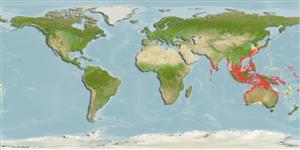Malacostraca |
Decapoda |
Penaeidae
Environment: milieu / climate zone / djupintervall / distribution range
Ekologi
; brackvatten; djupintervall 8 - 95 m (Ref. 8), usually 20 - 60 m (Ref. 409). Tropical; 36°N - 35°S, 72°E - 165°W
Indo-West Pacific.
Length at first maturity / Size / Weight / Age
Könsmognad: Lm ?, range 4 - ? cm Max length : 15.4 cm BL hane/ej könsbestämd; (Ref. 409); 18.9 cm BL (female); publicerad maxvikt: 18.00 g (Ref. 116487)
Maximum carapace length: 3.5 cm (male); 4.2 cm (female) (Ref. 8). Common body length: 7.0 to 14.0 cm (Ref. 409). Minimum depth range from Ref. 111048. Subtidal (Ref. 106854). Found mainly in turbid waters down to a depth of 95 m over bottoms of mud, sandy-mud or silt. Juveniles are found in estuaries and backwaters, also in seagrass beds, mangrove banks, mud flats, and open channels (Ref. 8) while adults are found in deeper waters (Ref. 10). Juveniles from a riverine mangrove are likely to obtain nutrition from phytoplankton and possibly epiphytic algae than from mangrove leaves or detritus (Ref. 105141). Omnivore (Ref. 116259).
Life cycle and mating behavior
Könsmognad | Reproduktion | Lek | Eggs | Fecundity | Larvae
Members of the order Decapoda are mostly gonochoric. Mating behavior: Precopulatory courtship ritual is common (through olfactory and tactile cues); usually indirect sperm transfer.
Holthuis, L.B. 1980 FAO Species Catalogue. Vol. 1. Shrimps and prawns of the world. An annotated catalogue of species of interest to fisheries. FAO Fish. Synop. 125(1):271 p. Rome: FAO. (Ref. 8)
IUCN Red List Status
(Ref. 130435: Version 2025-1)
CITES status (Ref. 108899)
Not Evaluated
Not Evaluated
Threat to humans
Human uses
Fiskeri: kommersiellt viktig; bete: occasionally
FAO - Vattenbruk: production; | FishSource | Sea Around Us
Verktyg
Ytterligare information
PhysiologySyreförbrukning
Human RelatedStamps, coins, misc.
Internet-källor
Estimates based on models
Preferred temperature
(Ref.
115969): 24.2 - 29.1, mean 28.1 (based on 1590 cells).
Resiliens
Hög, lägsta populationsfördubblingstid mindre än 15 månader (K=1.49-1.52).
Fishing Vulnerability
Low vulnerability (10 of 100).
Nutrients : Calcium = 109 [35, 184] mg/100g; Iron = 1.59 [1.21, 1.97] mg/100g; Protein = 20.2 [19.2, 21.3] %; Omega3 = 0.285 [0.185, 0.386] g/100g; Selenium = 48.3 [-31.7, 128.3] μg/100g; VitaminA = 0 μg/100g; Zinc = 1.79 [1.17, 2.40] mg/100g (wet weight); based on
nutrient studies.
